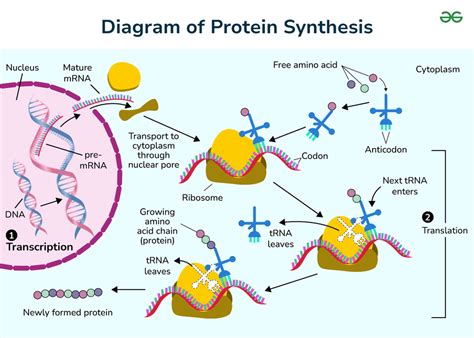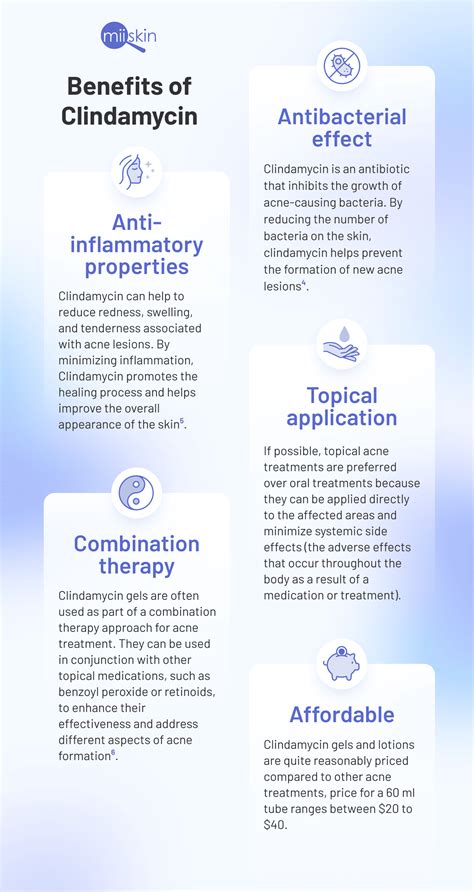Intro
Discover how Clindamycin works as an antibiotic, targeting bacterial infections, acne treatment, and skin infections with its antimicrobial properties, mechanism of action, and effective dosage forms.
The use of antibiotics has revolutionized the treatment of bacterial infections, saving countless lives and improving the quality of life for millions of people around the world. Among the various antibiotics available, Clindamycin is a popular choice for treating a range of bacterial infections, including skin and soft tissue infections, respiratory tract infections, and infections of the female reproductive organs. But have you ever wondered how Clindamycin works its magic? Let's dive into the world of antibiotics and explore the mechanisms of action of this powerful drug.
Clindamycin is a type of antibiotic known as a lincosamide, which works by inhibiting the growth of bacteria. It is effective against a wide range of bacteria, including both Gram-positive and Gram-negative bacteria, although its efficacy against the latter is generally lower. The drug is particularly useful for treating infections caused by anaerobic bacteria, which are bacteria that thrive in environments with low oxygen levels. By understanding how Clindamycin works, we can appreciate the importance of this antibiotic in modern medicine and the role it plays in combating bacterial infections.
The discovery of Clindamycin dates back to the 1960s, and since then, it has become a staple in the treatment of various bacterial infections. Its effectiveness and relatively low toxicity have made it a popular choice among healthcare professionals. However, like all antibiotics, Clindamycin is not without its limitations and potential side effects. As we explore the mechanisms of action of Clindamycin, we will also discuss its benefits and drawbacks, as well as the importance of using antibiotics responsibly to minimize the risk of resistance and other complications.
Introduction to Clindamycin

Clindamycin is a semi-synthetic antibiotic derived from lincomycin, a naturally occurring antibiotic produced by the bacterium Streptomyces lincolnensis. It is available in various forms, including capsules, tablets, and topical creams, and is commonly used to treat a range of bacterial infections. The drug works by binding to the 50S subunit of the bacterial ribosome, which is responsible for protein synthesis. By inhibiting protein synthesis, Clindamycin prevents the growth and replication of bacteria, ultimately leading to their death.
How Clindamycin Inhibits Protein Synthesis

The mechanism of action of Clindamycin involves the inhibition of protein synthesis in bacteria. The drug binds to the 50S subunit of the bacterial ribosome, which is responsible for translating messenger RNA (mRNA) into proteins. By binding to the ribosome, Clindamycin prevents the formation of the 70S initiation complex, which is necessary for protein synthesis to occur. As a result, the bacteria are unable to produce the proteins necessary for growth and replication, ultimately leading to their death.
Benefits of Clindamycin

Clindamycin has several benefits that make it a popular choice for treating bacterial infections. Some of the key benefits include:
- Effective against a wide range of bacteria, including anaerobic bacteria
- Available in various forms, including capsules, tablets, and topical creams
- Relatively low toxicity compared to other antibiotics
- Can be used to treat a range of infections, including skin and soft tissue infections, respiratory tract infections, and infections of the female reproductive organs
Common Uses of Clindamycin

Clindamycin is commonly used to treat a range of bacterial infections, including:
- Skin and soft tissue infections, such as abscesses and cellulitis
- Respiratory tract infections, such as pneumonia and bronchitis
- Infections of the female reproductive organs, such as pelvic inflammatory disease and endometritis
- Bone and joint infections, such as osteomyelitis and septic arthritis
- Dental infections, such as periodontitis and dental abscesses
Side Effects of Clindamycin

Like all antibiotics, Clindamycin can cause side effects, some of which can be serious. Some of the common side effects of Clindamycin include:
- Diarrhea and abdominal pain
- Nausea and vomiting
- Rash and itching
- Increased risk of Clostridioides difficile (C. diff) infection
- Increased risk of antibiotic resistance
Precautions and Contraindications

Clindamycin is contraindicated in patients with a history of hypersensitivity to the drug or other lincosamides. It is also contraindicated in patients with a history of C. diff infection or other inflammatory bowel diseases. Precautions should be taken when using Clindamycin in patients with a history of asthma, eczema, or other allergies, as well as in patients with kidney or liver disease.
Resistance to Clindamycin

The overuse and misuse of antibiotics, including Clindamycin, have contributed to the development of antibiotic resistance. Resistance to Clindamycin can occur through various mechanisms, including:
- Genetic mutation
- Horizontal gene transfer
- Selection of resistant bacterial populations
Minimizing the Risk of Resistance

To minimize the risk of resistance, it is essential to use antibiotics responsibly and only when necessary. Some strategies for minimizing the risk of resistance include:
- Using antibiotics only for bacterial infections
- Completing the full course of treatment
- Avoiding the use of broad-spectrum antibiotics
- Using narrow-spectrum antibiotics whenever possible
- Implementing infection control measures, such as hand hygiene and proper wound care
What is Clindamycin used for?
+Clindamycin is used to treat a range of bacterial infections, including skin and soft tissue infections, respiratory tract infections, and infections of the female reproductive organs.
How does Clindamycin work?
+Clindamycin works by inhibiting protein synthesis in bacteria, preventing the growth and replication of bacteria, and ultimately leading to their death.
What are the common side effects of Clindamycin?
+Common side effects of Clindamycin include diarrhea, abdominal pain, nausea, vomiting, rash, and itching, as well as an increased risk of C. diff infection and antibiotic resistance.
Can Clindamycin be used to treat viral infections?
+No, Clindamycin is only effective against bacterial infections and should not be used to treat viral infections.
How can I minimize the risk of resistance to Clindamycin?
+To minimize the risk of resistance, use antibiotics only when necessary, complete the full course of treatment, and avoid the use of broad-spectrum antibiotics.
In conclusion, Clindamycin is a powerful antibiotic that has revolutionized the treatment of bacterial infections. By understanding how Clindamycin works and its benefits and drawbacks, we can appreciate the importance of responsible antibiotic use and the need to minimize the risk of resistance. If you have any questions or comments about Clindamycin or antibiotic use in general, please feel free to share them below. Additionally, if you found this article informative, please consider sharing it with others to help spread awareness about the importance of responsible antibiotic use.
